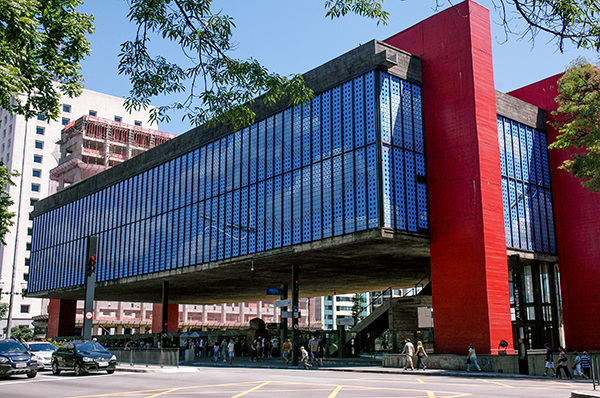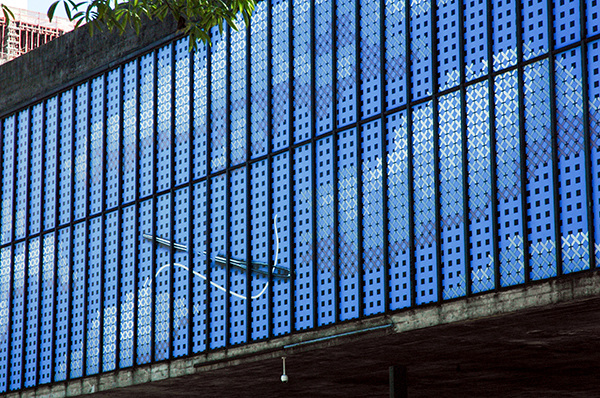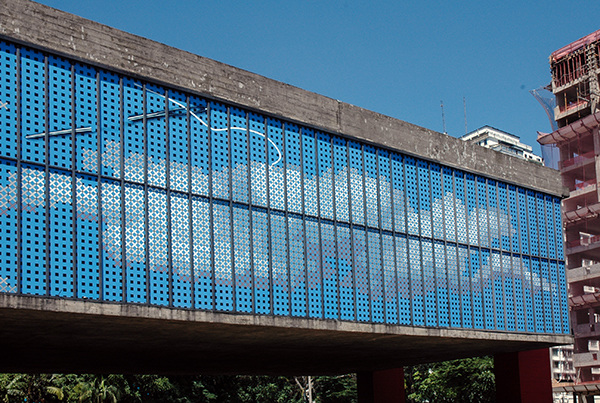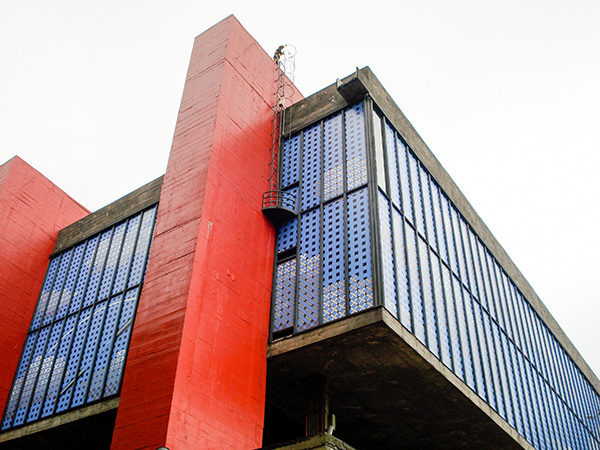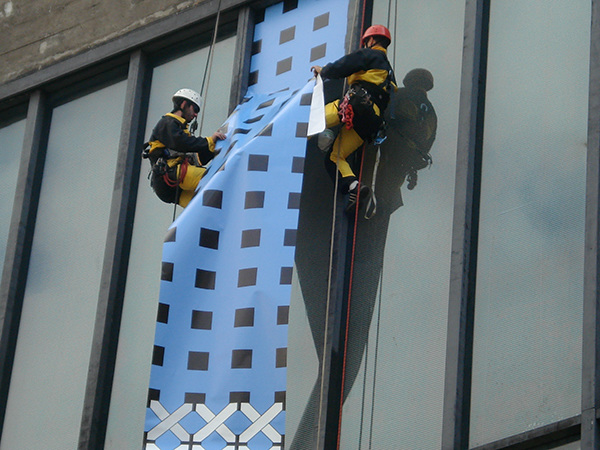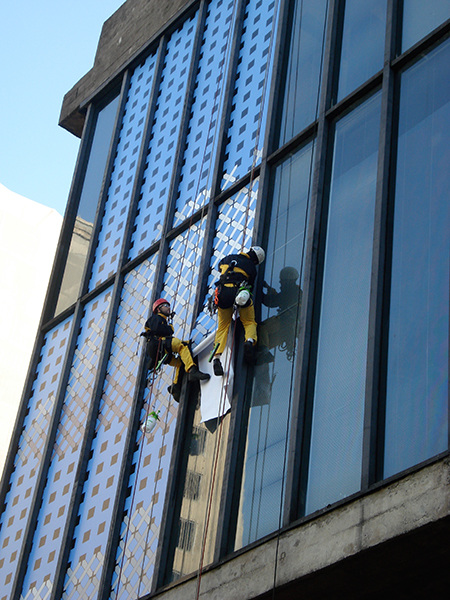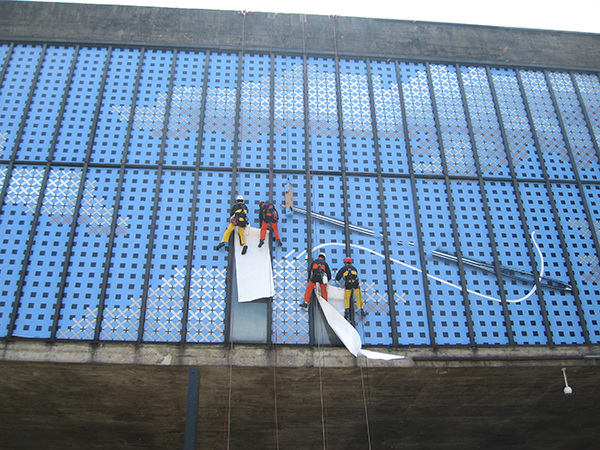
TRAMAZUL
Tramazul
2010
Impressão digital sobre vinil adesivo
2300 m2 (aprox.)
Museu de Arte de São Paulo Assis Chateaubriand, São Paulo, Brasil
Imagens do processo
de instalação da obra
Sobre parar e depois sumir
Teixeira Coelho, curador
Há muitos céus hoje, na arte. Sempre houve, na história da arte. Hoje, talvez mais – porque são personagens centrais, não apenas coadjuvantes de alguma outra cena. Não seria difícil para um estudo do imaginário buscar os motivos dessa tendência. Mas, por que, agora, um céu bordado, um céu portanto duplamente evidente? Talvez porque em São Paulo o céu nunca esteja visível, mesmo estando aí. Chegando a São Paulo por avião, o céu é uma barra marrom-amarelo pesando sobre a cidade e anulando o céu verdadeiro. Em Congonhas, há muito tempo, na abóboda do saguão interior que distribui as pessoas para seus destinos, havia uma abóboda e nela um céu pintado, “realista”. Congonhas é o teto de São Paulo, Congonhas já é o céu de São Paulo – mas também em Congonhas era preciso haver um outro céu a abrir um falso buraco para o céu real que os aviões furam a todo instante. Talvez sejam necessários vários céus em São Paulo, vários céus sobre São Paulo. Há uma história do céu sobre São Paulo, que agora inclui mais este.
Regina Silveira tem feito vários céus. Interiores, como no Museu Vale, em Vitória; e exteriores, como para uma biblioteca de Nova York (que ainda não se concretizou). Interiores, como na Pinacoteca, há não muito tempo. Exteriores, como este agora no MASP, enorme, envolvente. Regina trabalhou muito tempo em preto & branco, com sombras escuras, por vezes ameaçadoras. Agora convoca céus, azuis & brancos.
Seu tom, neste caso, é o de arte pública, arte urbana como se diz também, de modo talvez algo torto (a arte é sempre urbana ou não é). Como São Paulo ainda é muito feia, com uma arquitetura apressada, rabiscada, empacotada, apertada, sobreposta, num cenário comprimido, a arte pública deveria ser um recurso permanente. Ainda não é. Regina Silveira vem há tempos dedicando-se ao gênero, talvez mais no exterior, onde a receptividade e a consciência dessa necessidade são mais intensas. Mesmo assim, alguém se lembrará de um tropel que ela aplicou à fachada da Bienal, há alguns anos, e de outras instalações ou “passeios” (com projeções) menos ou mais provisórias pelas ruas da cidade. No exterior, dois casos se destacam: a fachada do Taipei Fine Arts Museum, de Taiwan, e o Palácio de Cristal em Madrid, antológicos em sua história pessoal.
Uma arte singular, a sua. Não é difícil de apreender – ao contrário de muitas outras que ainda insistem na rarefação do sentido -, sem deixar de ser sofisticada nos recursos e efeitos. Fazer um céu bordado poderia apontar para a opção por uma “arte de gênero”, como eufemisticamente se diz hoje em vez de apontar-se para o que está por trás dessa palavra: uma arte de sexo, com sexo. O céu é bordado, portanto, de acordo com o código pronto, seria um céu feminino, anti-feminista ou pós-feminista, conforme a leitura. É um céu bordado, um céu que precisar ser colado a uma fachada que nunca serviu tanto à arte como agora. O céu em São Paulo escapa aos olhos, portanto ao corpo, com assombrosa rapidez: o céu colado ficará estacionado algum tempo no MASP. Com ele, o tempo ficará também parado, como parados ficarão os que quiserem dele usufruir. Arte contemporânea contra o fluxo das coisas e no entanto arte contemporânea que em pouco tempo sumirá dessa fachada, ela também – uma arte que aceita sumir. A eterna precariedade dos céus encontra-se com a transitoriedade da arte atual, em harmonia passageira.
__________________________________________________
About stopping and then fading away
Teixeira Coelho, chief curator
There are a number of skies today, in art. There has always been, in the history of art. Today, there are maybe even more – and as central characters of the story, not just like supporting characters of someone else’s or something’s else story anymore. It wouldn’t be hard to carry out a study on the reasons for this tendency. But why, now, an embroidered sky, a sky which is therefore twice as evident? Maybe because in São Paulo the sky is never visible, even though it is there. On arriving in São Paulo by plane, the sky is a brown-yellow bar weighing down over the city and cancelling the true sky. In Congonhas, a long time ago, on the dome over the internal lobby which distributes people to their destinations, there was a painted sky, a “realistic” one. Congonhas is the roof of São Paulo, Congonhas is already the sky of São Paulo – but in Congonhas also it was necessary to have another sky opening a false hole to the real sky that the planes tear through all the time. Maybe a number of skies are needed in São Paulo, a number of skies over São Paulo. The sky of São Paulo has a history, which now includes this one also.
Regina Silveira has done many skies. Interior ones, like in the Museu Vale, in Vitória; and exterior ones, such as the one for a New York library (which has not yet been installed). Interior ones, like in the Pinacoteca, quite recently. Exterior ones, such as this one now in the MASP, enormous, enthralling. Regina worked for a long time in black&white, with dark shades, often threatening. Now she calls on skies, blues&whites.
Her tone, in this case, is that of public art, urban art as it is also called, in a somewhat twisted way perhaps (art is always urban or it is not). As São Paulo is still very ugly, with a hasty type of architecture, dashed off, packed, squashed, piled up, in a crammed setting, public art should be a permanent resource. It still isn’t. Regina Silveira has dedicated herself to this genre for a long time, possibly more abroad, where the receptivity and awareness of this need are more intense. Even so, some will remember a ‘”stampede” that she applied to the facade of the Bienal, a few years ago, and other installations or “walking-by” (with projections) less or more provisional through the streets of the city. Abroad, two cases stand out: the facade of the Taipei Fine Arts Museum, in Taiwan, and the Palácio de Cristal in Madrid, anthological in her personal history.
Regina Silveira’s is a singular art. It is not hard to understand it – contrary to many others who still insist on rarefied meanings. Yet, she is all too sophisticated in her resources and effects. An embroidered sky could point towards the option for a “gender art”, as we euphemistically say today instead of emphasizing what is behind this word: an art of a sex, an art with a sex. The sky is embroidered, therefore, according to the established code, it would be a feminine sky, an anti-feminist or post-feminist one, depending on the interpretation. It is an embroidered sky, a sky that needs to be stuck to a façade that has never served art as much as now. The sky in São Paulo evades the eye, therefore the body, with frightening speed: this one will stay parked for some time at the MASP. With it, time will also stay still, as will those who want to appreciate it. A token of contemporary art that is contrary to the flow of things, a contemporary art that opens to another state of the things. And yet a contemporary art that will soon disappear from this façade itself – a work of art which accepts to disappear. The eternal precariousness of the skies meets the transitory nature of today’s art, in a provisional harmony.
Você não pode copiar conteúdo desta página. Todos os direitos reservados.
